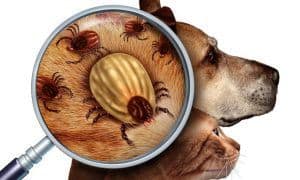“This post contains affiliate links, and I will be compensated if you make a purchase after clicking on my links.”
Responsible pet owners know that tick prevention is important – but not always 100% effective. Chances are, at some point in your dog’s life, you’ll encounter one of these icky arthropods that attach themselves to your dog’s skin and feast on their blood. When left untreated, a tick can cause a whole slew of problems for your dog including anemia, fever, lethargy, and in some cases even paralysis. Not to mention, they’re dangerous for humans too, carrying Lyme and other tick-borne diseases. That’s why, with a little help from the ASPCA, we’re providing readers with this great step-by-step guide to removing a tick from your dog’s skin.
Step-By-Step Guide to Removing a Tick From Your Dog’s Skin
Step 1—Prepare its Final Resting Place
Throwing a tick in the trash or flushing it down the toilet will not kill it, and it’s actually best to hold on to it for awhile for veterinary testing in case your pet falls ill from the bite. Be ready with somewhere to put the tick after you’ve removed it—the best option is a screw-top jar containing some rubbing alcohol.
Step 2—Don’t Bare-Hand It
Put on latex or rubber gloves so you’ll never have direct contact with the tick or your pet’s bite area. Ticks can carry infective agents that may enter your bloodstream through breaks in your skin or through mucous membranes (if you touch your eyes, nostrils or mouth).
Step 3—Grab a Partner
You don’t want your pet squirming away before you’re finished, so if possible, have a helper on hand to distract, soothe or hold her still.
Step 4—The Removal
Treat the bite area with rubbing alcohol and, using a pair of tweezers, grasp the tick as close to the animal’s skin as possible. Pull straight upwards with steady, even pressure. Place the tick in your jar.
- Do not twist or jerk the tick! This may leave the mouth-parts embedded in your pet, or cause the tick to regurgitate infective fluids.
- Do not squeeze or crush the body of the tick, because its fluids (saliva and gut contents) may contain infective organisms.
Step 5—All that Remains
Sometimes, in spite of doing everything right, a tick’s mouth-parts will get left behind in your pet’s skin. If the area doesn’t appear red or inflamed, the best thing to do is to disinfect it and not to try to take the mouth-parts out. A warm compress to the area might help the body expel them, but do not go at it with tweezers.
Step 6—Clean Up
Thoroughly disinfect the bite site and wash your hands with soap and water (even though you were wearing gloves). Sterilize your tweezers with alcohol or by carefully running them over a flame.
Step 7—Keep Watch
Over the next few weeks, closely monitor the bite area for any signs of localized infection. If the area is already red and inflamed, or becomes so later, please bring your pet—and your jarred tick—to your veterinarian for evaluation.
Please note that once the tick is removed, you may notice a small bump at the bite location that could remain for up to 2 weeks. Continue to monitor the site until the bump disappears. As long as this small bump is not red or itchy and progressively gets smaller, there isn’t cause for concern. If the bump gets larger, becomes discolored, inflamed or infected, or otherwise continues to bother your dog, it’s time for a visit to your veterinarian.
This tried and true method of removing a tick from your dog’s skin, while not a fun experience, will ensure that you and your dog remain safe from the dangers of ticks. If you live in an area prone to ticks, or your dog spends time in tall grasses or heavily wooded areas, be sure to check your pet regularly for these pesky parasites. For more information on tick removal or to read more tips from the ASPCA, click here.
Do you have any special tick removal techniques of your own? Or, has your dog ever suffered any adverse effects from a tick bite? Tell us about it below, won’t you?

















Nikki
Jul 8, 2017 at 5:22 pm
I have a proper tick removal device & you don't just pull ticks straight upwards, you have to twist the tick to make sure that the head isn't left stuck in your pet & the tick removers twist the tick so it pulls out all intact. My dog was left with a small pimple like lump which isn't red or infected or anything like that so I'm just going to keep an eye on it to make sure it disappears. Do NOT pull a tick out any other way than twisting it out or your chances of the head being left in the skin are high!
Gwen
May 31, 2017 at 7:32 am
This information was very helpful. Thanks
Nikki
Jul 8, 2017 at 5:22 pm
I have a proper tick removal device & you don't just pull ticks straight upwards, you have to twist the tick to make sure that the head isn't left stuck in your pet & the tick removers twist the tick so it pulls out all intact. My dog was left with a small pimple like lump which isn't red or infected or anything like that so I'm just going to keep an eye on it to make sure it disappears. Do NOT pull a tick out any other way than twisting it out or your chances of the head being left in the skin are high!
DeannFGans
Apr 9, 2014 at 2:39 pm
my neighbor’s step-sister makes $73 an hour on the laptop . She has been without work for five months but last month her payment was $15623 just working on the laptop for a few hours. try this out …….
======= jobseg.com =========